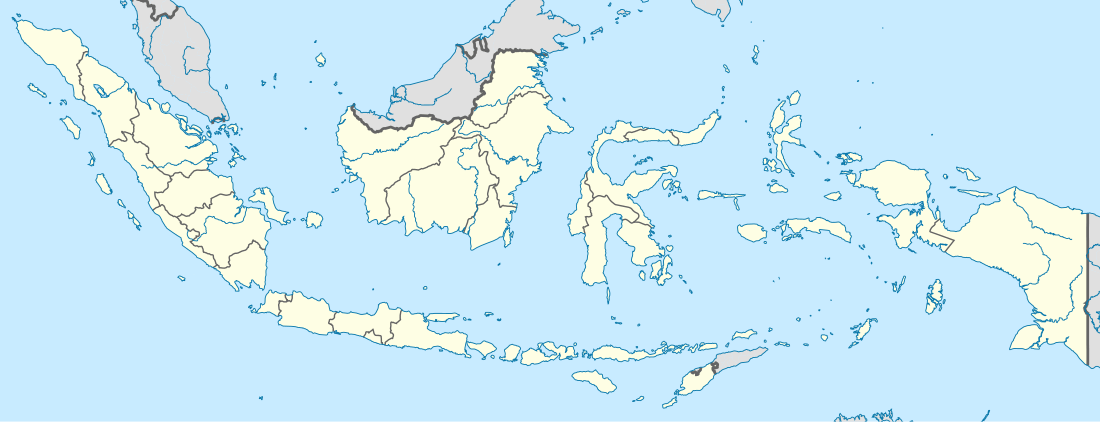Batujaya
Batujaya is an archeological site located in the village of Batujaya, Karawang in West Java, Indonesia. Archaeologist suggests that Batujaya temples might be the oldest surviving temple structure in Java, estimated was built during Tarumanegara kingdom circa 5th to 6th century CE.[1]

Batujaya, Karawang | |
|---|---|
 Batujaya, Karawang Location of Batujaya site, Karawang in Indonesia | |
| Coordinates: 6°18′0″S 107°0′0″E | |
| Country | Indonesia |
| Province | West Java |
The site is five square kilometers in area and comprises at least 30 structural[2] in what Sundanese call hunyur, or unur (high mounds of earth consisting of artifacts). Unur is similar to the manapo found at the Muara Jambi archaeological site.
Structure of the sites
The site was first found and examined by archaeologists from the University of Indonesia in 1984. Excavations have since uncovered 17 unur, of which three are in the form of pools. The structures found are made of bricks composed of a mixtures of clay and rice husks, not volcanic rock which is difficult to find in Batujaya. Two structures recovered are in the form of temples, one of which, known as Jiwa Temple, has been restored. According to Dr Tony Djubiantono, the head of Bandung Archeology Agency, Jiwa was built in the 2nd-century.
As local Indonesian governments do not maintain the site, Ford provides funds for research and excavation of the Batujaya complex as part of its Conservation and Environmental Grants.[3]
Advance technology has been applied for the construction with some of the floor and other parts of the temple which require hardening made of unreinforced concrete with marble-size stones and some of the temple is also coated with a thick enough of stucco.[4]
History
The discovery of this archaeological site was important as although it was the location of Tarumanagara, the oldest Hindu-Buddhist kingdom in Indonesia; West Java lacks ancient temple remains. Before the discovery, only four temple sites have been found in West Java, namely they are Cangkuang temple (in Garut), Ronggeng Temple, Pamarican Temple, and Pananjung Temple (in Ciamis).
Preliminary research at Jiwa found that the temple was built between the fifth and sixth centuries. This is based on the inscriptions found on numerous votive tablets discovered in the area, small clay tablets with inscriptions and pictures of Buddha used in prayer. Prof. Dr. Budihartono, a senior anthropologist from the University of Indonesia, proposed carrying out pollen analysis for examining both the paleoenvironment and also cultural records, including evidence of diet and food processing.
In and around the site is also discovered the fragments of Buni culture clay pottery, which suggests Buni prehistoric clay culture spread across West Java northern coast was the predecessor of Batujaya site.
In April 2019, the complex was declared as an Indonesian national cultural treasure.[5]
See also
References
- "Batujaya Temple (West Java) - Temples of Indonesia". candi.perpusnas.go.id. Retrieved 2020-08-09.
- "Candi Batujaya Dibangun dengan Teknologi Canggih". Archived from the original on August 25, 2017. Retrieved November 22, 2011.
- The Jakarta Post Archived August 17, 2007, at the Wayback Machine
- "Wah, Teknologi Beton Dikenal Sejak Zaman Tarumanegara". June 3, 2012. Archived from the original on January 28, 2013.
- "Batujaya Temple complex listed as national cultural heritage". The Jakarta Post. April 8, 2019. Retrieved October 5, 2019.
External links
| Wikivoyage has a travel guide for Batujaya. |
- The Spice Islands History
- Bambang Budi Utomo. 2004. Arsitektur Bangunan Suci Masa Hindu-Budha di Jawa Barat. Kementrian Kebudayaan dan pariwisata, Jakarta. ISBN 979-8041-35-6
- Percandian Batujaya, from Indonesian Wikipedia on 19 September 2005.